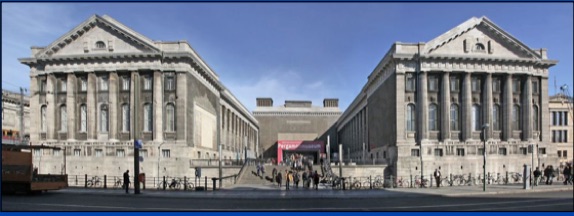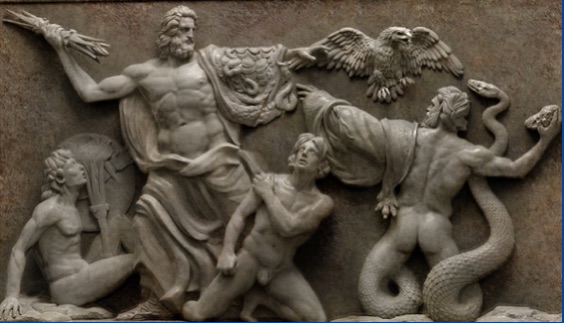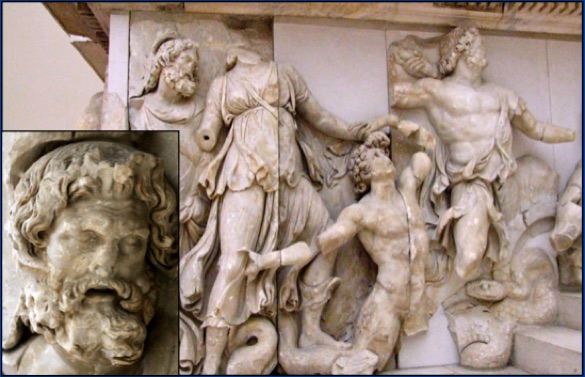On Sale Now from SolvingLight.com $24.95 + FREE SHIPPING = $24.95 total
Or Order from Amazon Paperback ($29) and Kindle
MORE THAN 160 FULL-COLOR IMAGES FROM THE ANCIENT WORLD

On Sale Now from SolvingLight.com $24.95 + FREE SHIPPING = $24.95 total
Or Order from Amazon Paperback ($29) and Kindle
MORE THAN 160 FULL-COLOR IMAGES FROM THE ANCIENT WORLD
To order by check or money order, contact: RBowieJ@comcast.net
JESUS IDENTIFIES THE THRONE OF SATAN WITH THE ALTAR OF ZEUS IN THE ANCIENT CITY OF PERGAMON

With the following words to the apostle John, Jesus Christ gives us the the key that opens the door to understanding what Satan’s religious system is, how it operated in the ancient Greek world, how it continues to operate today, and most importantly, Athena’s key role in it:
And to the messenger of the ecclesia in Pergamon write: “Now this He is saying Who has the sharp two-edged blade: ‘I am aware where you are dwelling—where the throne of Satan is . . . “ (Revelation 2:12-13).
The main feature of the acropolis of Pergamon on the west coast of ancient Anatolia (modern-day Turkey) was the altar of Zeus completed in 178 BC. Thus, in the above passage, by referring to the altar as the throne of Satan, Christ reveals to us that Zeus is a guise of “the ancient serpent called Adversary and Satan” (Revelation 12:9). The logical corollary is that the mankind-exalting Greek religious system is Satan’s religious system. A 120-meter-long frieze surrounding the altar of Zeus/throne of Satan vividly boasted of the gods (glorified ancestors in the way of Cain) defeating the Giants, or Seth-men, the God-believing sons of Noah.
Reconstructed view of the acropolis of Pergamon in 150 BC with the altar of Zeus/throne of Satan in the foreground. Friedrich Thierch, 1882

The Pergamon Museum in Berlin, current home of the altar of Zeus/throne of Satan
The altar of Zeus remained intact on the heights of Pergamon until the tenth century. Then, the Byzantines used the frieze plates to construct a defensive wall on the fortress-hill in their war against Islam, and the ancient treasures gradually disappeared into the dirt. In the early 1870s, a German engineer named Carl Humann who had been hired to build a highway in Asia Minor, was drawn to Pergamum where he discovered and unearthed some of the frieze plates. In 1878, a planned excavation of the fortress-hill terrain began under Humann’s direction. Over the years, the Germans conducted negotiations with the Turkish government, making possible the acquisition of the Pergamum discoveries for the Berlin Museum. There, in 1880, some sculptures were shown for the first time.
It was not until 1930 that the western side of the altar of Zeus, the throne of Satan, was erected in a room in the newly built Pergamon Museum. Shortly after that, Adolph Hitler seized power. He was a man determined to eradicate God’s chosen people, the Jews. These were a people who directed their worship exclusively to the God of Noah/Nereus. The rest of that story you should know.

The altar of Zeus/throne of Satan reassembled in the Pergamon Museum, as it looks today.
SUMMARY OF THE ALTAR OF ZEUS/THRONE OF SATAN FROM
Genesis Characters and Events in Ancient Greek Art:
King Eumenes II of Pergamon, ordered the great altar built as a tribute to both Zeus and Athena in 183 BC, and it was most likely completed in 178 BC. The kings of Pergamon looked across the Aegean Sea to Athens for their inspiration in religion and art. For Pergamum as well as Athens, Athena was protectress of the city.
The 120-meter-long frieze surrounding the altar of Zeus/throne of Satan vividly boasted of the gods (glorified ancestors in the way of Cain) defeating the Giants, or Seth-men, the God-believing sons of Noah. The ancients approached the altar of Zeus from the east. Their first view was of Zeus and Athena—victors in the front rank of the battle surging toward all sides. The image of Herakles does not survive but an inscription puts him to the left of Zeus. According to the ancient lyric poet, Pindar, and others, the Giants could not be defeated without the help of the great rebel whom we know to be the Nimrod of Genesis transplanted to Greek soil as Herakles, raised as a child in the way of Cain by his grandmother, Naamah/Athena.
Taking part in this great victory are all the chief Greek gods: Zeus, Athena, Hermes, Hera, Herakles, Artemis, Apollo, Dionysos, Hephaistos, Ares, Poseidon, Aphrodite, and Nike. The Altar of Zeus includes all of these, and it is so epically grandiose that it makes room for lesser deities such as the Three Fates, Amphitrite, Leto, Helios, Eos, Themis, Hekate, Nyx, and Selene to play a part in the utter routing of the Seth-men.
The defeat of the God-believing sons of Noah by Cainite ancestors glorified as gods is the culminating event, the great celebration, of ancient Greek religion. This is the fundamental assertion made by the ancient poets, vase-artists, and sculptors: the man-centered Greek religious system has overcome the God-believing descendants of Noah.
Zeus-religion relegated the Supreme God of the Scriptures to the status of a non-entity, and elevated the “wisdom” of the Genesis serpent embraced by humanity to the supreme heights. When we understand that Zeus-religion is Satan’s system—the way of Cain triumphant, mankind exalted, and God discarded—many aspects of the spiritual history of humanity fit together like an easy-to-solve jigsaw puzzle.

Artist’s reconstruction on the scene on the altar of Zeus with Zeus crushing the Giants, the God-fearing sons of Noah (Seth-men). The legs of the Seth-man to the right turn into serpents, making him unable to stand and fight Zeus.
When we examine the artist’s reconstruction of the scene with Zeus, above, and the scene with Athena, below, we note that it is not Zeus, the king of the gods (the deification of the first man, Adam, the progenitor of all mankind) who is crowned, but rather it is Athena who receives the wreath of triumph from Nike. Why is that? The victory of Adam/Zeus took place in the ancient garden when he and Eve welcomed the serpent’s “enlightenment.” The sculptures on the altar of Zeus/throne of Satan boast of the triumph of the way of Cain in post-Flood world, and it was Naamah/Athena who inspired and led that post-Flood rebellion on behalf of her father Zeus/Satan and the way of Cain.
Thus Athena is the idol-image of the demonic spirit of this present wicked eon (Galations 1:4).
As a created being, Zeus/Satan is not an originator of spiritual things, but rather an imitator of God’s operations. Just as Jesus Christ is the “wisdom of God and the power of God,” so Athena is the wisdom of Satan and the power of Satan.
Just as Christ came out of God, so we shall see that Greek vase artists made it very clear that Athena came out of Zeus/Satan.

NIKE CROWNS ATHENA AS VICTORIOUS ON THE THRONE/ALTAR OF HER FATHER ZEUS/SATAN
From the east frieze, Nike approaches Athena from our right to crown her as victorious as she and the serpent bring down the winged Seth-man Enkelados. Athena drives his head downward as the serpent, entwined about his body with fangs locked into his breast, pulls him to the earth.

Artist’s reconstruction of the scene above. Nike crowns Athena as the wisdom and power of Zeus/Satan
ON THE ALTAR OF ZEUS/SATAN, THE ARTISTS SCULPTED NOAH AS A DEJECTED WITNESS TO ATHENA’S POST-FLOOD TRIUMPH

Look at the old man to the left on this part of the frieze. His face is solemn and sad, and he is the only living male on the entire frieze who is not actively engaged in the battle. From one of the corners, the sculptors have made him an observer of this horrendous defeat of the line of Seth.
This is Nereus, the Greek Noah. Greek religious art chronicles the great post-Flood spiritual change that took place after the Flood. Greek artists often used Noah/Nereus as a constant against whom they were able to portray this great change. This device was artistically effective and historically accurate.
Next to Nereus stands his wife, Doris, unnamed in Genesis. She reaches out to lift one of her sons by his hair as his legs of are turning into serpents—signifying that he is no longer has firm legs upon which he can stand and fight the onslaught of Zeus-religion.
From the point of view of Scripture, Noah and his wife are forced to witness an “abomination of desolation.” Recognition of the Creator of the universe ends, and humanity elevates and worships Zeus/Satan and Athena, the glorified Cainite woman Naamah, who came through the Flood as Ham’s wife and inspired the post-Flood rebellion.